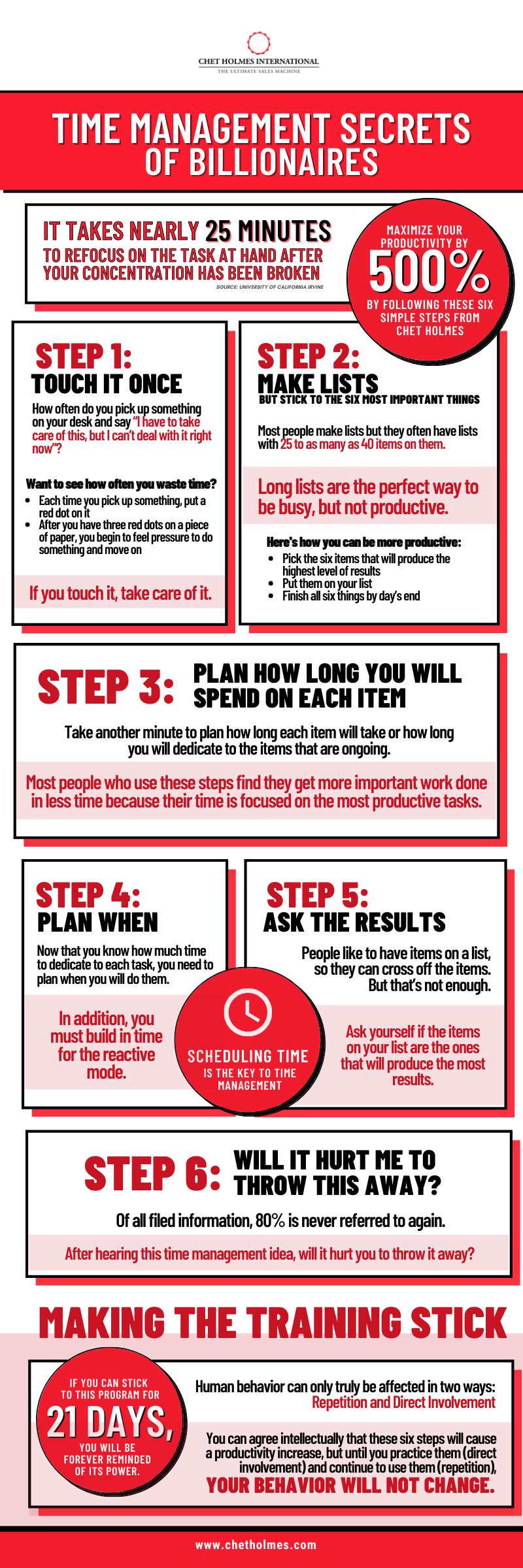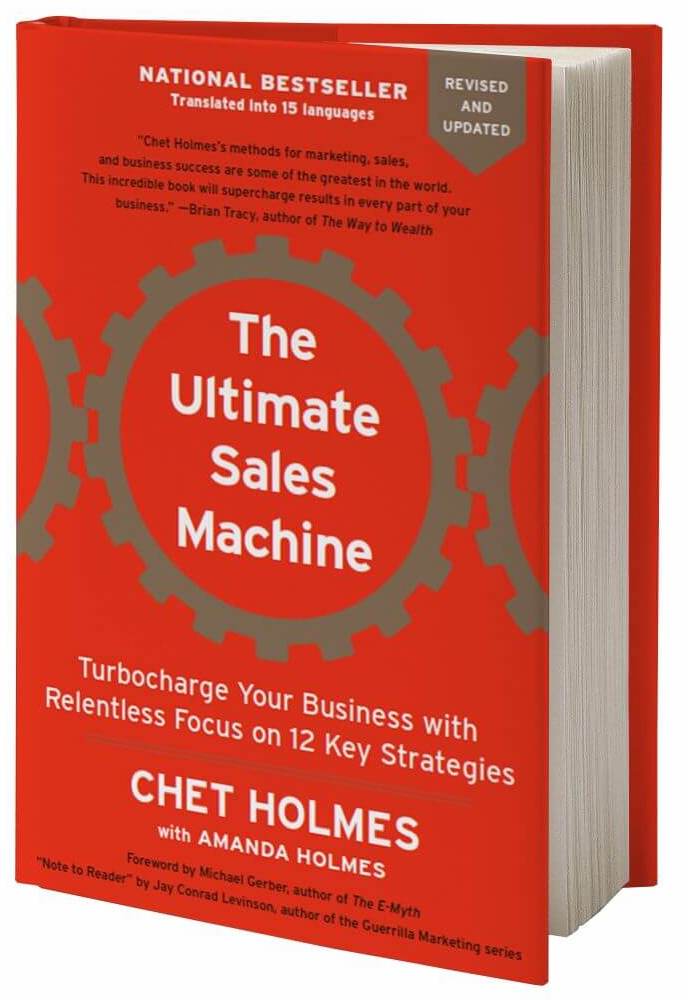
Are you inundated by constant notifications and interruptions? You could be hurting your bottom line.
According to a University of California Irvine study, it takes nearly 25 minutes to refocus on the task at hand after your concentration has been broken; for modern business owners, high distraction levels could be costly.
Entrepreneur interviewed me to get the six simple steps to maximize productivity by 500% and it only takes 5 minutes a day. I reveal the time management secrets from our late founder, Chet Holmes, in his book The Ultimate Sales Machine.
Originally, Chet learned these strategies while working for Berkshire Hathaway Vice-President Charlie Munger (Warren Buffet’s business partner). He noticed Charlie’s time was maximized in every way and once he adopted the practices of his billionaire boss, he found the secret to mastering time effectively. Chet always used to say that majority of businesses are terrible at time management, and if he could see how we waste it with our phones today, he’d be utterly shocked.
6 STEPS TO INCREASE PRODUCTIVITY BY 500%
Six proactive steps to time management can transform your day. They take five minutes to do and can double the amount of results you get daily. The problem is not whether or not these steps will work because they absolutely will. The problem is whether or not you will fully commit to doing them, repeatedly. Download the Time Management worksheet to follow along with the article RIGHT NOW! The key to time management is committing to the following six steps:
Step One: Touch it once
How often do you pick up something on your desk and say, “I have to take care of this, but I can’t deal with it right now”?
If you do that a few times per day with a few different documents/projects/tasks, by the end of the year, you will have spent an entire month touching and rereading information without taking action. So, if you touch it, move it to the next step. If you want to see how often you waste time, each time you pick up something, put a red dot on it. After you have three red dots on a piece of paper, you begin to feel pressure to do something and move on. If you touch it, take care of it.
Step Two: Make lists, but stick to the six most important things
When we conduct this time management seminar, we ask how many people in the audience make lists. Practically everyone does. People often have lists with 25 to as many as 40 items on them. They are proud that their lists are so long and that they are so busy.
Further investigation quickly shows them that long lists are the perfect way to be busy, but not productive. When you have a long list, your energy is focused more on trimming the list than it is on being productive. Each day, pick the six items that will produce the highest level of results, put them on your list, and finish all six things by day’s end.
Step Three: Plan how long you will spend on each item
You’ve started your day by making a list of the six most important things. That took two or three minutes. Now, take another minute to plan how long each item will take or how long you will dedicate to the items that are ongoing.
When we conduct this workshop, the people with long lists usually find that they can have an incredibly productive day with only six hours spent on their six key items. Most people who use these steps find they get more important work done in less time because their time is focused on the most productive tasks.
Step Four: Plan when
Now that you know how much time to dedicate to each task, you need to plan when you will do them. In addition, you must build in time for the reactive mode.
For example, if you are a sales manager interrupted by frequent “got a minute” meetings, plan a fixed time when you will accept those types of meetings. Otherwise, unless it is an emergency, do not allow people to come to your desk and ask if you’ve got a minute!
Think of any top executive you know. Can you simply call them up, or do you have to schedule time with them? Many top executives plan their day down to the minute. Everything is done according to a schedule, including time for “got a minute” meetings. Scheduling time is the key to time management.
Step Five: Ask the results
Few people are highly productive. People like to have items on a list, so they can cross off the items. But that’s not enough.
The things that produce the best results are generally the most difficult. Thus, they get left off of the list or are scheduled at the end of the day, causing them to get bumped to the next day…and the next…and the next.
Schedule important tasks at the beginning of your day. Cold calling or trying to get appointments with key prospects or clients are the things that produce the best results. However, they often get pushed off by average salespeople. After you make your list, ask yourself if the items on it are the ones that will produce the most results.
HERE’S AN EXAMPLE OF A MANAGER’S DAY
- 8:00 – 8:30 am Plan day; have quick look at staff’s planned day.
- 8:30 – 9:30 am Work on a strategy to overcome our new, most frequently heard objection.
- 9:30 – 10:00 am Create a standard promotional piece or standard letter that addresses the problem.
- 10:00 – 12:00 pm On sales call with Bill
- 12:00 – 1:30 pm Lunch with an important client, Smith
- 1:30 – 2:00 pm Miscellaneous
- 2:00 – 3:00 pm Got-A-Minute meetings
- 3:00 – 4:00 pm Review “Six Musts of Marketing” for the month
- 4:00 – 5:00 pm Work on improving systems
- 5:00 – 6:00 pm Meet with Boss
Question: How much of this day is proactive?
Answer: All but 90 minutes
NOW IT’S YOUR TURN!
Get your copy of the Time Management Secrets of Billionaires Worksheet now
Step Six: Will it hurt me to throw this away?
Of all filed information, 80% is never referred to again. After hearing this time management idea, I began to throw away four out of five of the items I used to keep. It’s been 10 years, and I cannot think of a single time where it has hurt me.
Making The Training Stick
Human behavior can only truly be affected in two ways: Repetition and direct involvement. You can agree intellectually that these six steps will cause a productivity increase, but until you practice them (direct involvement) and continue to use them (repetition), your behavior will not change.
The common wisdom is that it takes 21 days to form a new habit. My experience is that it takes years. But for now, if you can stick to this program for just 21 days, you will be forever reminded of its power, and you will be more likely to use these important steps.
To hear the full interview, it only takes 40 minutes to press play below. It could be the best 40 minutes you spend this year if adopted with PIG HEADED DISCIPLINE AND DETERMINATION.
Solution
We’re here to help you grow faster, better, smarter! We have shared the Time Management Secrets of Billionaires Worksheet for your own implementation here.
If you really want to have a massive impact today, schedule your own 1 on 1 breakthrough strategy call where we find you a breakthrough in your business in under 20 minutes, click HERE to get your complimentary session!





 Get your pre-sale copy of the new edition of The Ultimate Sales Machine! (With special limited time bonuses)
Get your pre-sale copy of the new edition of The Ultimate Sales Machine! (With special limited time bonuses)
0 Comments